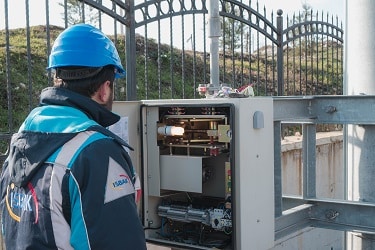A warehouse explosion leads to prosecutions of a retail company and an electrical contracting company after an electrician suffered serious burns to 15 per cent of his body.
On 22 September 2018, an electrician was using a metal spanner to repair an electrical fault at B&M Retail Ltd warehouse, in Speke. The spanner he was using came into contact with a live busbar (metallic strip) linked to the power distribution causing an electrical explosion.
Explosion
The 35-year-old electrician sustained serious injuries which included burns to his arms, hands, thighs, legs, and face in the explosion. He was placed in an induced coma for two weeks and had to undergo several skin grafts. As a result of the incident the electrician was unable to work for five months.
“I am very conscious of the scars and always think people are staring at me or talking about me behind my back. To me, my arms look like Freddy Kruger’s from Nightmare on Elm Street. I now can’t play with my little boys as much as I used to and I’m worried about hurting myself, and they are worried about hurting me. I have paranoia of being touched. I do worry about the future as I know the pain will never go away and might get worse, leaving me unable to work and support my family.”

HSE investigation into the explosion
An investigation by the Health and Safety Executive (HSE) found that the victim, who was employed by Daker Ltd, had been attempting to connect a generator to B&M’s Low Voltage supply in order to allow B&M to operate some of its core site functions whilst high voltage maintenance was being undertaken. This work was complex involving several contractors and required co-ordination of different working parties with specific time limited requirements. There was insufficient planning between parties beforehand including who was in charge of each site, coordination of work and exchange of relevant documentation prior to the explosion which could have been avoided.
B&M failed to appoint a suitably competent person to plan and carry out the work to connect temporary generators to their distribution board at the premises
Electrical contractors Daker Ltd.’s work methods fell well below the required standards. Electrical work commenced without proper planning. The power supply to the circuit was not stopped prior to the incident and live working was allowed to take place, this meant that the power supply could be switched on or off at any point, putting workers at risk of electric shock.
Following the explosion, B&M Retail Ltd of Speke, Liverpool pleaded guilty to breaching Section 2 (1) and Section 3 (1) of the Health and Safety at Work etc. Act 1974. At Liverpool Crown Court, the company was fined £1,000,000 and ordered to pay costs of ££4,978.
Daker Ltd of Bolton pleaded guilty to breaching Section 2 (1) of the Health and Safety at Work etc. Act 1974 and was fined £100.
“This incident has had life-changing consequences on the victim and his family. It could have been avoided if the companies involved had taken the time to appropriately plan and coordinate tasks to ensure the circuit was dead, eliminating the risk of electrocution to workers. Working with electricity is a high-risk activity and safety must be a priority.”
Roger Clarke, HSE Inspector
Use of contractors
The explosion in this case was the result of poor planning and coordination between the various parties involved in the project. Anyone engaging contractors has health and safety responsibilities, both for the contractors and anyone else that could be affected by their activities. Contractors themselves also have legal health and safety responsibilities. When contractors are appointed, it is important to ensure that everyone understands the part they need to play in ensuring health and safety (client, principal contractor, sub-contractors, etc).
Use of contractors in itself does not result in poor health and safety standards, but poor management can lead to injuries, ill health, additional costs and delays. Working closely with the contractor will reduce the risks to your own employees and the contractors themselves.
Remember that contractors may be at particular risk – they may be strangers to your workplace and therefore unfamiliar with your organisation’s procedures, rules, hazards and risks. Even regular contractors may need reminding. The level of control needed will, of course, be proportionate to the complexity of the task. Where a task is complex then more control will be required, and planning plays a key role in this. On sites with major accident hazards, consider turnarounds and span of control – given the potentially very high numbers of contractors on-site (compared with the numbers in routine operations).
Some projects may fall within the scope of the Construction (Design and Management) Regulations 2015 which detail the responsibilities of clients, principal contractors and others.
If you require advice on health and safety in your workplace, please contact one of the Ashbrooke team.
